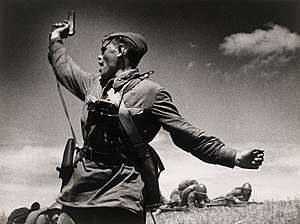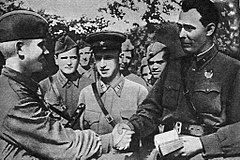Political commissar
In the military, a political commissar or political officer (or politruk, a portmanteau from Russian: политический руководитель, pronounced politicheskiy rukovoditel, translated "political leader", "political official"), is a supervisory officer responsible for the political education (ideology) and organization of the unit they are assigned to, and intended to ensure civilian control of the military.
The function first appeared as commissaire politique (political commissioner) or représentant en mission (representative on mission) in the French Revolutionary Army during the Revolution (1789–99).[1] It also existed, with interruptions, in the Soviet Red Army from 1918 to 1942, as well as in the armed forces of Nazi Germany from 1943 to 1945 as Nationalsozialistischer Führungsoffiziere (national-socialist leadership officers). The function remains in use in China's People's Liberation Army.
Soviet Union and the Eastern Bloc
An early kind of political commissars arose already during the February Revolution 1917 as the Ispolkom issued the controversial Order no 1.[2] As the Bolsheviks came to power through the October Revolution 1917, and as the Russian Civil War began, Trotsky who then gradually established the Red Army, imposed the formal political officers. These were almost invariably tasked to make sure the communist party of the respective country could count on the loyalty of the Army. Although there was a huge difference between the February Revolution and the October Revolution, their leaders both feared a counter-revolution, and both regarded the military officers as the most likely counter-revolutionary threat.[3][4]
In the Soviet Union


The political commissar is often associated with the Soviet Union (1922–91), where the Cheka introduced them to the military forces to ensure the government’s political control. The chief reason was because the newly created Red revolutionary military units were associated with different, often conflicting political parties, and there were so many leftist political parties and movements at that time, who despite differing doctrines supported the Bolsheviks seizure of power. They all had party members and sympathizers among the military, and tried to use that to benefit their viewpoint. The Left SRs and the Anarchists were among such hard-nosed competitors, who were popular among the lower ranks no less than bolsheviks, contesting them quite frequently. The Bolsheviks saw this as a matter of life and death during the ongoing civil war against the White movement. To gain permanent control over the entire military, they introduced the commissarship. Another reason was the frequent appointment of ex-Tsarist officers to command positions. Worried about giving increased influence to officers with potential White movement sympathies, the commissars helped ensure that army units remained under Bolshevik control. After the SRs were left behind, the forces loyal to them split off from the Red Army to create the Green armies, and guerrilla war soon erupted in the countryside along with civil war. The commissars' task was to prevent the warfighters, both commanding officers and troops, from tending towards the rivalrious political authorities. There were many examples of defiance and outspoken disobedience, when the troops killed or banished their commissars and switched sides, going Green. After the Bolsheviks eliminated all their rivals, they became the one and only political entity in the country, creating a one-party dictatorship.
In the Red Army and the Soviet Army, the political commissar (Russian: комиссар, romanized: komissar) existed, by name, only during the 1918–24, 1937–40, and 1941–42 periods; not every Red Army political officer was a commissar. The political commissar held military rank equaling that of the unit commander to whom he was attached; moreover, the commissar also had the military authority to countermand the unit commander’s orders when required. In the periods of the Red Army's history when political officers were militarily subordinate to unit commanders, the position of political commissar did not exist.
The political supervision of the Russian military was effected by the political commissar, who was introduced to every unit and formation, from company- to division-level, including the navy. Revolutionary Military Councils (or Revvoyensoviets, RVS) were established at army-, front-, fleet-, and flotilla-level, comprising at least three members—commander and two political workers. The political workers were denominated "members of the RVS", not "commissars", despite being official political commissars.
In 1919, the title politruk (Russian: политрук, from политический руководитель, political leader) was assigned to political officers at company level. Despite being official political commissars, they were not addressed as "commissar". Beginning in 1925, the politico-military doctrinal course towards edinonachalie (Russian: единоначалие, single command) was established, and the political commissar, as a military institution, was gradually abolished. The introduction of edinonachalie was twofold, either the military commander joined the Communist Party and became his unit’s political officer, or a pompolit (Russian: помполит, assistant commander for political work) officer was commissioned sub-ordinate to him. Earlier, in 1924, the RVSs were renamed as Military Councils, such high-level political officers were known as ChVS (Chlen Voennogo Soveta, Member of the Military Council), they were abolished in 1934.
On 10 May 1937 the political commissar was reinstated to the Red Army, and Military Councils were created. These events derived from the political purges that began in the Soviet armed forces. Again, in August 1940, the political commissars was abolished, yet the Military Councils continued throughout the German-Soviet War (1941–45), and afterwards. Below army level, the edinonachalie (single command) system was restored. In July 1941, consequent to the Red Army’s defeats at war’s start, the position of political commissar reappeared. The commissar had an influential role as a "second commander" within the military units during this time. Their ranks and insignia generally paralleled those of officers.[5] When this proved less-than-effective, General Konev asked Stalin to subordinate the political officer to commanding officers: the commissars' work was refocused to morale-related functions. The term "commissar" itself was formally abolished in August 1942, and at the company- and regiment-level, the pompolit officer was replaced with the zampolit (deputy for political matters). Though no longer known by the original "commissar" title, political officers were retained by all the Soviet Armed Forces, e.g., Army, Navy, Air Force, Strategic Missile Troops, et al, until the dissolution of the Soviet Union in 1991.
Eastern Bloc armies
After World War II, other Eastern Bloc armies also used political officers patterned on the Soviet model. For example, East Germany's Nationale Volksarmee used Politoffiziere as the unit commander's deputy responsible for political education.
Red Army rank designations
- Armeysky komissar 1-go ranga (comparable to NATO OF-9a; en: Commissar of the army 1st rank)
- Armeysky komissar 2-go ranga (OF-9b; Commissar of the army 2nd rank)
- Korpusnoy komissar (OF-8; Commissar of the corps)
- Divizionny komissar (OF-7; Commissar of the division)
- Brigadny komissar (OF-6; Commissar of the brigade)
- Polkovoy komissar (OF-5; Commissar of the regiment)
- Starshi batalonny komissar (OF-4; Senior commissar of the battalion)
- Batalonny komissar (OF-3; Commissar of the battalion)
- Starshy politruk (OF-2; Senior politleader)
- Politruk (OF-1a; Politleader)
- Mladshy politruk (OF-1b; Junior politleader)
Nazi Germany
From December 1943 until the defeat of Nazi Germany, the German armed forces created a network of political instructors to maintain National Socialist indoctrination of the Wehrmacht.[6] The officers, called Nationalsozialistische Führungsoffiziere (NSFO; "National Socialist Leadership Officers"), drawn from convinced officers and approved by Martin Bormann, head of the Nazi Party Chancellery, to instill ideological conviction and reinforce combat morale through training lessons and teaching. They had no direct influence on combat decisions as had the political commissar in the Soviet Army. At the end of 1944 more than 1,100 full-time and about 47,000 part-time instructors had been trained under the overall control of General Hermann Reinecke, commander of the National Socialist leadership staff at the OKW.
The NSFO Chiefs of Staff of the Service Branches were:
- Army: Generaloberst Ferdinand Schörner (until 15 May 1944), then General der Gebirgstruppe Georg Ritter von Hengl
- Navy: Vizeadmiral Friedrich Hüffmeier (until 21 June 1944), then Konteradmiral Erich Alfred Breuning
- Air Force: Generaloberst Bruno Loerzer
- SS: SS-Brigadeführer und Generalmajor der Waffen-SS Ernst Fick
China
The position of political commissar (zhengwei, Chinese: 政治委员, 政委) also exists in the People's Liberation Army of China. Usually, the political commissar is a uniformed military officer and Communist Party cadre, although this position has been used to give civilian party officials some experience with the military. The political commissar was head of a party cell within the military; however, military membership in the party has been restricted to the lower ranks since the 1980s. Today the political commissar is largely responsible for administrative tasks such as public relations and counseling, and mainly serves as second-in-command.
The position of political commissar (Chinese: 政戰官) also exists in the Republic of China Army of the Republic of China (Taiwan). Chiang Ching-kuo, appointed as Kuomintang (Chinese Nationalist Party) director of Secret Police in 1950, was educated in the Soviet Union, and initiated Soviet style military organization in the Republic of China Military, reorganizing and Sovietizing the political officer corps, surveillance, and Kuomintang party activities were propagated throughout the military. Opposed to this was Sun Li-jen, who was educated at the American Virginia Military Institute.[7] Chiang Ching-kuo then arrested Sun Li-jen, charging him of conspiring with the American CIA of plotting to overthrow Chiang Kai-shek and the Kuomintang. Sun was placed under house arrest in 1955.[8][9]
See also
References
Citations
- R. Dupuy, Nouvelle histoire de la France contemporaine: La République jacobine (2005) p.156
- Richard Pipes, The Russian Revolution, Swedish ISBN 91-27-09935-0, pp 106-108
- Richard Pipes, The Russian Revolution, Swedish ISBN 91-27-09935-0, p.120
- Isaac Deutscher,"Stalin",2nd edition, 1961, Swedish ISBN 91-550-2469-6, pp.168-169
- Commissar Ranks?
- Müller 2016, p. 14.
- Jay Taylor (2000). The Generalissimo's son: Chiang Ching-kuo and the revolutions in China and Taiwan. Harvard University Press. p. 195. ISBN 0-674-00287-3. Retrieved 2010-06-28.
- Peter R. Moody (1977). Opposition and dissent in contemporary China. Hoover Press. p. 302. ISBN 0-8179-6771-0. Retrieved 2010-11-30.
- Nancy Bernkopf Tucker (1983). Patterns in the dust: Chinese-American relations and the recognition controversy, 1949-1950. Columbia University Press. p. 181. ISBN 0-231-05362-2. Retrieved 2010-06-28.
- Source: The Soviet Military Encyclopedia
Bibliography
Müller, Rolf-Dieter (2016). Hitler's Wehrmacht, 1935-1945. Translated by Ancker, Janice W. University Press of Kentucky. ISBN 9780813168043.CS1 maint: ref=harv (link)